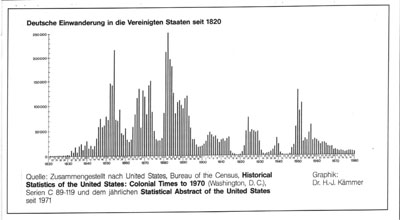1. Germany as a “country of emigrants“
Embarkation
 Click image to enlarge
Click image to enlarge
Waves of emigration
 Click image to enlarge
Click image to enlarge
Questions
Description and Analysis
The picture shows the troubles and difficulties of emigration. It gives a good idea of how crowded those ships were and it also clearly indicates that emigration was not cheap.
The graph shows the three most important waves of German emigration to the United States. The pupils are asked to find out what were the political and socio-economic reasons for emigration. They should distinguish between the three waves:
- The first wave caused by problems related to industrialization and by the failed Revolution of 1848.
- The second wave which to some extent was the result of the fear of wars.
- The third wave motivated by the economic crisis.
They discuss the motives of the emigrants.
Geographical/Historical Context
After 1830 emigration from Germany to the United States began to increase. There were several reasons for that, but you can name two general trends. One of them was the fact that the population grew rapidly, which was not only a German phenomenon but happened also in other countries, such as Denmark, Finland, Great Britain, Belgium, Austria-Hungary and Italy. Another reason was that during the 19th century agriculture lost its importance. And even though the conditions in German states were not as bad as in Ireland which suffered from the potato famine of the ‘Hungry-Forties’, German states also suffered from wheat crop failures and the decline of rural production robbed workers of their income. The lives of rural inhabitants became less secure. Moreover, inheritance laws, high prices, and the effects of the industrial revolution led to widespread poverty. Those who emigrated first wrote home and encouraged their relatives and friends to follow. This is called "chain migration" and led to group settlements.
Politically-motivated migration also began in the 1830s when the reactionary government persecuted Liberals and Democrats. But in total only several thousand revolutionaries left the country after the failed German Revolution of 1848, most of whom at first considered themselves asylum seekers rather than emigrants. As a reaction to Bismarck’s Anti-Socialist Laws some Social Democrats moved to the East Coast of the USA.
During the last thirty years of the 19th century most German immigrants came from regions east of the Elbe river. One of the reasons for that was that the local grain farmers could no longer compete with the prices of grain from the Midwest of the USA.
Until the end of the century more than 5 million Germans entered the United States.




Presentation
The picture is a fragment of a drawing from the 19th century. You can see the embarkation of emigrants.
Germany as a country of emigration: Until the end of the 19th century Germany was a country of emigration, only in the 1880s it became a country people moved to. The migrant workers came mainly from Poland and Italy. The Germans left their country mainly for economic reasons. In the 19th century there were three major waves of emigration: the first one in 1845-1857 (30% of all emigrants), the second in 1864-1873/74 (35%) and the third wave between 1880-1893 (28% of all emigrants).